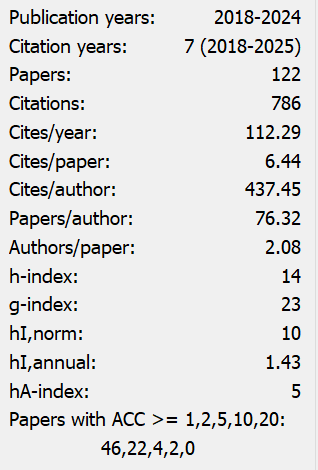The Role of Banking Institutional Services on the Sustainable growth of SMEs in Cameroon
Abstract
Banking institutions have been very instrumental to the growth of Small and Medium Sized enterprises in many developed economies, and they have been considered as one of the principal driving forces for economic development. The case has not been the same for Cameroon as owner managers of these SMEs have been complaining of the limited presence of banking institutions in solving their problems. Mindful of the fact that Cameroon has a growth vision to become an emerging economy by 2035, the country had to take giant steps to boast the growth of SME in the country. Some of these steps were the introduction of the small business law in 2010. This was all in a drive to ensure that SME contribute to GDP growth, reduce unemployment, alleviate poverty and act as an engine for the country’s emergence growth. It is therefore in this light that a study was carried out on the role of banking institutional services on the sustainable growth of SME in Cameroon. A logistic regression model was adopted to examine the impact of banking institutions on the growth of SMEs in Cameroon. The data used in the study was extracted from the 2016 Cameroon Enterprise Survey which was collected from 361 enterprises by the National Institute of Statistics in the country. From the empirical results, it was discovered that 68.4% of the enterprises were growing as opposed to 31.6%. Despite the high growth rate of these SME bank loans were affecting the growth of SME negatively while MFI loans, electronic banking services, internal funds and research and development were positively contributing to the growth of SME in the country. Thus, we concluded the study by emphasisng the implementation of relationship lending which will contribute positively to the growth of SMEs and more so fiscal policies should be ameliorated to boast the growth of startups businesses.
References
Aghion, P., & Bolton, P. (1997). A theory of trickle-down growth and development. The Review of Economic Studies, 64(2), 151-172. https://doi.org/10.2307/2971707
Akhavein, J. D., Frame, W. S., & White, L. J. (2001). The diffusion of financial innovations: An examination of the adoption of small business credit scoring by large banking organizations.
Aladwani, A. M. (2001). Online banking: a field study of drivers, development challenges, and expectations. International journal of information management, 21(3), 213-225. https://doi.org/10.1016/S0268-4012(01)00011-1
Allison, P. D. (1999). Comparing logit and probit coefficients across groups. Sociological Methods & Research, 28(2), 186-208. https://doi.org/10.1177/0049124199028002003.
Al-Somali, S. A., Gholami, R., & Clegg, B. (2009). An investigation into the acceptance of online banking in Saudi Arabia. Technovation, 29(2), 130-141. https://doi.org/10.1016/j.technovation.2008.07.004
Amin, A. A. (2002). An examination of the sources of economic growth in Cameroon. AERC.
Ammar, A., & Ahmed, E. M. (2016). Factors influencing Sudanese microfinance intention to adopt mobile banking. Cogent Business & Management, 3(1), 1154257. https://doi.org/10.1080/23311975.2016.1154257
Ayyagari, M., Demirgüç-Kunt, A., & Maksimovic, V. (2011). Small vs. young firms across the world: contribution to employment, job creation, and growth. World Bank Policy Research Working Paper, (5631).
Beck, T., & Demirguc-Kunt, A. (2006). Small and medium-size enterprises: Access to finance as a growth constraint. Journal of Banking & finance, 30(11), 2931-2943. https://doi.org/10.1016/j.jbankfin.2006.05.009
Beck, T., Demirgüç‐Kunt, A. S. L. I., & Maksimovic, V. (2005). Financial and legal constraints to growth: does firm size matter?. The journal of finance, 60(1), 137-177.
Beck, T., Demirgüç-Kunt, A., & Maksimovic, V. (2008). Financing patterns around the world: Are small firms different? Journal of financial economics, 89(3), 467-487. https://doi.org/10.1016/j.jfineco.2007.10.005
Berger, A. N., & Udell, G. F. (1995). Relationship lending and lines of credit in small firm finance. Journal of business, 351-381.
Berger, A. N., & Udell, G. F. (2002). Small business credit availability and relationship lending: The importance of bank organisational structure. The Economic Journal, 112(477), F32-F53. https://doi.org/10.1111/1468-0297.00682
Berger, A. N., De Young, R., & Udell, G. F. (2001). Efficiency barriers to the consolidation of the European financial services industry. European Financial Management, 7(1), 117-130. https://doi.org/10.1111/1468-036X.00147
Cressy, R. (2002). Introduction: funding gaps. The Economic Journal, 112(477), F1-F16. https://doi.org/10.1111/1468-0297.00680
Davidsson, P., Achtenhagen, L., & Naldi, L. (2010). Small firm growth. Now Publishers Inc.
De la Torre, A., Pería, M. S. M., & Schmukler, S. L. (2010). 9 Drivers and Obstacles to Banking SMEs: The Role of Competition and the Institutional Framework. Reforming Rules and Regulations: Laws, Institutions, and Implementation, 215. https://doi.org/10.1596/1813-9450-4788
De Mel, S., McKenzie, D., & Woodruff, C. (2012). One-time transfers of cash or capital have long-lasting effects on microenterprises in Sri Lanka. Science, 335(6071), 962-966. https://doi.org/10.1126/science.1212973
Demirgüç-Kunt, A., Beck, T., & Maksimovic, V. (2002). Financing patterns around the world: The role of institutions. The World Bank. https://doi.org/10.1596/1813-9450-2905
Dmytrenko, A. L. (1997). Cost benefit analysis. Information Management, 31(1), 16.
Fonchamnyo, D. C. (2012). ’The altruistic motive of remittances a panel data analysis of economies in Sub Saharan Africa’. International Journal of Economics and Finance, 4(10), 192-200. https://doi.org/10.5539/IJEF.V4N10P192
Goudreault, S., & Hébert, M. (2013). Pour développement économique misant sur les PME. Avis de la FCEI concernant le Projet de loi no 36: Loi sur la Banque de développement économique du Québec.
Growth, C. (2010). Employment Strategy Paper (2009). Growth and Employment Cameroon.
Guo wu yuan fa zhan yan jiu zhong xin, Development Research Center of the State Council, & The World Bank. (2013). China 2030: Building a Modern, Harmonious, and Creative Society. World Bank Publications. https://doi.org/10.1596/978-0-8213-9545-5
Hernández-Cánovas, G., & Martínez-Solano, P. (2010). Relationship lending and SME financing in the continental European bank-based system. Small Business Economics, 34(4), 465-482. https://doi.org/10.1007/s11187-008-9129-7
Josefy, M. A., Harrison, J. S., Sirmon, D. G., & Carnes, C. (2017). Living and dying: Synthesizing the literature on firm survival and failure across stages of development. Academy of Management Annals, 11(2), 770-799. https://doi.org/10.5465/annals.2015.0148
Jun, M., & Cai, S. (2001). The key determinants of internet banking service quality: a content analysis. International journal of bank marketing. https://doi.org/10.5465/annals.2015.0148
Jusufi, G., & Gashi-Sadiku, F. (2020). Impact of Fiscal Policies on Western Balkan SMEs’ Growth: Evidence from Kosovo. Central European Public Administration Review, 18(2), 135-164. https://doi.org/10.17573/cepar.2020.2.07
Keen, P. G. (1997). The process edge: creating value where it counts. Harvard Business Press.
Kevane, M., & Wydick, B. (2001). Microenterprise lending to female entrepreneurs: sacrificing economic growth for poverty alleviation? World development, 29(7), 1225-1236. https://doi.org/10.1016/S0305-750X(01)00032-8
Khan, A. A., Shaik, M. V., Parveen, N., Rajendraprasad, A., Aleem, M. A., Habeeb, M. A., ... & Venkateswarlu, J. (2010). Human fetal liver-derived stem cell transplantation as supportive modality in the management of end-stage decompensated liver cirrhosis. Cell transplantation, 19(4), 409-418. https://doi.org/10.3727/096368909X484707a
Lopez-Nicolas, C., & Soto-Acosta, P. (2010). Analyzing ICT adoption and use effects on knowledge creation: An empirical investigation in SMEs. International Journal of Information Management, 30(6), 521-528. https://doi.org/10.1016/j.ijinfomgt.2010.03.004
Mansor, N., Shariff, A., & Manap, N. R. A. (2012). Determinants of awareness on Islamic financial institution e-banking among Malaysian SMEs. International Journal of Business and Social Science, 3(5).
Mensah, S. (2004, March). A review of SME financing schemes in Ghana. In A Presentation at the UNIDO Regional Workshop of Financing SMEs (pp. 15-16). Ghana: Accra.
Mols, N. P., Bukh, P. N. D., & Nielsen, J. F. (1999). Distribution channel strategies in Danish retail banking. International Journal of Retail & Distribution Management. https://doi.org/10.1108/09590559910252694.
Ngaruiya, B. (2014). Effects of mobile money transactions on financial performance of small and medium enterprises in Nakuru central business district (Doctoral dissertation, Egerton University).
Obamuyi, T. M. (2009). 8.4 An Exploratory Study of Loan Delinquency among Small and Medium Enterprises (SMEs) in Ondo State, Nigeria. Labour and management in development, 8.
OECD, O. (2004). The OECD principles of corporate governance. Contaduría y Administración, (216). https://doi.org/10.22201/fca.24488410e.2005.562
Owusu, J., Osman, M. H. B. M., Ismail, M. B., & Latif, A. A. B. A. (2017). A conceptual framework for financing sme growth in Ghana. European Journal of Business and Management, 9(19), 11-13.
Peek, J., & Rosengren, E. S. (1996). The use of capital ratios to trigger intervention in problem banks: Too little, too late. New England Economic Review, 49-58.
Petersen, M. A., & Rajan, R. G. (1995). The effect of credit market competition on lending relationships. The Quarterly Journal of Economics, 110(2), 407-443. https://doi.org/10.2307/2118445.
Prakash, A., & Malik, G. (2008). Empirical Study of Internet Banking in India. Curie journal, 1(3).
Pyun, C. S., Scruggs, L., & Nam, K. (2002). Internet banking in the US, Japan and Europe. Multinational Business Review, 10(2), 73.
Safoulanitou, L. N., Zamo-Akono, C., & Ndiwulu, X. B. (2013). PME et Innovation: une Analyse Comparative Entre le Cameroun, le Congo et la RDC/SMEs and Innovation: a Comparative Analysis between Cameroon, Congo and DRC.
Schiffer, M., & Weder, B. (2001). Firm size and the business environment: Worldwide survey results. The World Bank. https://doi.org/10.1596/978-0-8213-5003-4.
Scott, J. A., & Dunkelberg, W. C. (2003). Bank mergers and small firm financing. Journal of Money, Credit and Banking, 999-1017.
Sen, B. A., & Taylor, R. (2007). Determining the information needs of small and medium-sized enterprises: A critical success factor analysis. Information Research, 12(4), 12-4.
Sohail, M. S., & Shanmugham, B. (2003). E-banking and customer preferences in Malaysia: An empirical investigation. Information Sciences, 150(3-4), 207-217. https://doi.org/10.1016/S0020-0255(02)00378-X.
Stiglitz, J. E., & Weiss, A. (1981). Credit rationing in markets with imperfect information. The American economic review, 71(3), 393-410.
St-Pierre, J., & Cadieux, L. (2011). The conception of performance: What links with the entrepreneurial profile of owner managers of SMEs ? Journal of Entrepreneurship, 10(1), 33-52.
Vaillancourt, R. R., Heasley, L. E., Zamarripa, J., Storey, B., Valius, M., Kazlauskas, A., & Johnson, G. L. (1995). Mitogen-activated protein kinase activation is insufficient for growth factor receptor-mediated PC12 cell differentiation. Molecular and Cellular Biology, 15(7), 3644-3653. https://doi.org/10.1128/MCB.15.7.3644
Wagenvoort, R. (2003). SME finance in Europe: introduction and overview. EIB Papers, 8(2), 11-20.
World Bank, W. B. (2014). LAC Poverty and Labor Brief, February 2014: Social Gains in the Balance-A Fiscal Policy Challenge for Latin America and the Caribbean. The World Bank. https://doi.org/10.1596/978-1-4648-0291-1
World Bank. (2003). Education in Rwanda: Rebalancing resources to accelerate post-conflict development and poverty reduction. The World Bank. https://doi.org/10.1596/0-8213-5610-0

This work is licensed under a Creative Commons Attribution 4.0 International License.
Copyright for this article is retained by the author(s), with first publication rights granted to the journal.
This is an open-access article distributed under the terms and conditions of the Creative Commons Attribution license (http://creativecommons.org/licenses/by/4.0/).


























